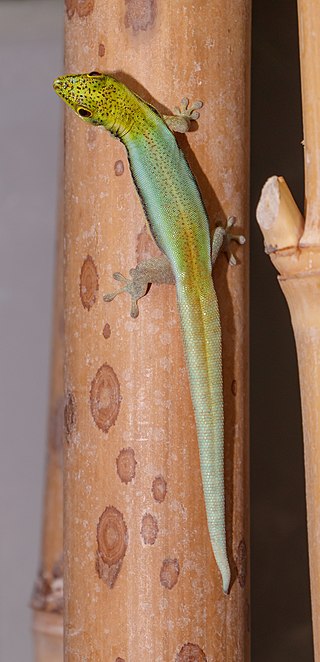
The yellow-headed day gecko, also commonly called Klemmer's day gecko, the neon day gecko, or the cheerful day gecko, is a small diurnal species of gecko, a lizard in the family Gekkonidae. This endangered species is endemic to northwestern Madagascar and inhabits coastal forests, dwelling on bamboo. The yellow-headed day gecko feeds on insects and nectar.

Paroedura is a genus of geckos, endemic to Madagascar and the Comoros. These geckos are typically terrestrial, though the young of most species can climb until they are too heavy for their feet to support.

Uroplatus is a genus of geckos, commonly referred to as leaf-tail geckos or flat-tailed geckos, which are endemic to Madagascar and its coastal islands, such as Nosy Be. They are nocturnal, insectivorous lizards found exclusively in primary and secondary forest.

The common flat-tail gecko is a gecko endemic to Madagascar. It is found in eastern Madagascar and on the islands Nosy Bohara and Nosy Mangabe. These geckos live in tropical rain forests. They reach a total length of 330 mm.

Ebenavia maintimainty is a small nocturnal gecko species of the genus Ebenavia that is native to Madagascar. It is found in a small area of limestone cliffs to the east of Lake Tsimanampetsotsa on the Mahafaly Plateau. This habitat forms part of the Madagascar spiny thickets ecoregion.

Uroplatus sikorae, commonly referred to as the mossy leaf-tailed gecko or the southern flat-tail gecko, is a species of lizard in the family Gekkonidae. The species is endemic to Madagascar. It is a CITES II protected animal due to habitat loss.

Blaesodactylus boivini is a species of gecko, a lizard in the family Gekkonidae. The species is endemic to Madagascar.

Matoatoa brevipes is a species of gecko, a lizard in the family Gekkonidae. The species is endemic to Madagascar.

Matoatoa spannringi is a species of gecko part of the lizard family Gekkonidae. The species is endemic to Madagascar.
Paragehyra gabriellae is a species of lizard in the family Gekkonidae. The species is endemic to Madagascar.

Angel's petite gecko is a species of lizard in the family Gekkonidae. The species is endemic to Madagascar.

The northern Madagascar ground gecko is a species of lizard in the family Gekkonidae. It is endemic to Madagascar.

The Ibity ground gecko is a species of lizard in the family Gekkonidae. It is endemic to Madagascar.
Paroedura maingoka is a species of lizard in the family Gekkonidae. It is endemic to Madagascar.
Paroedura tanjaka is a species of lizard in the family Gekkonidae. It is endemic to Madagascar.
Paroedura vahiny is a species of lizard in the family Gekkonidae. It is endemic to Madagascar.
Paroedura vazimba is a species of lizard in the family Gekkonidae. It is endemic to Madagascar.

Phelsuma borai is a species of gecko, a lizard in the family Gekkonidae. The species is endemic to Madagascar.

Uroplatus alluaudi, also known commonly as the northern flat-tail gecko and the northern leaf-tail gecko, is a species of lizard in the family Gekkonidae. The species is endemic to Madagascar.

Uroplatus pietschmanni, known commonly as the cork-bark leaf-tail gecko, the cork bark leaftail gecko, and the spiny leaf-tailed gecko, is a species of lizard in the family Gekkonidae. The species is endemic to Madagascar.


















